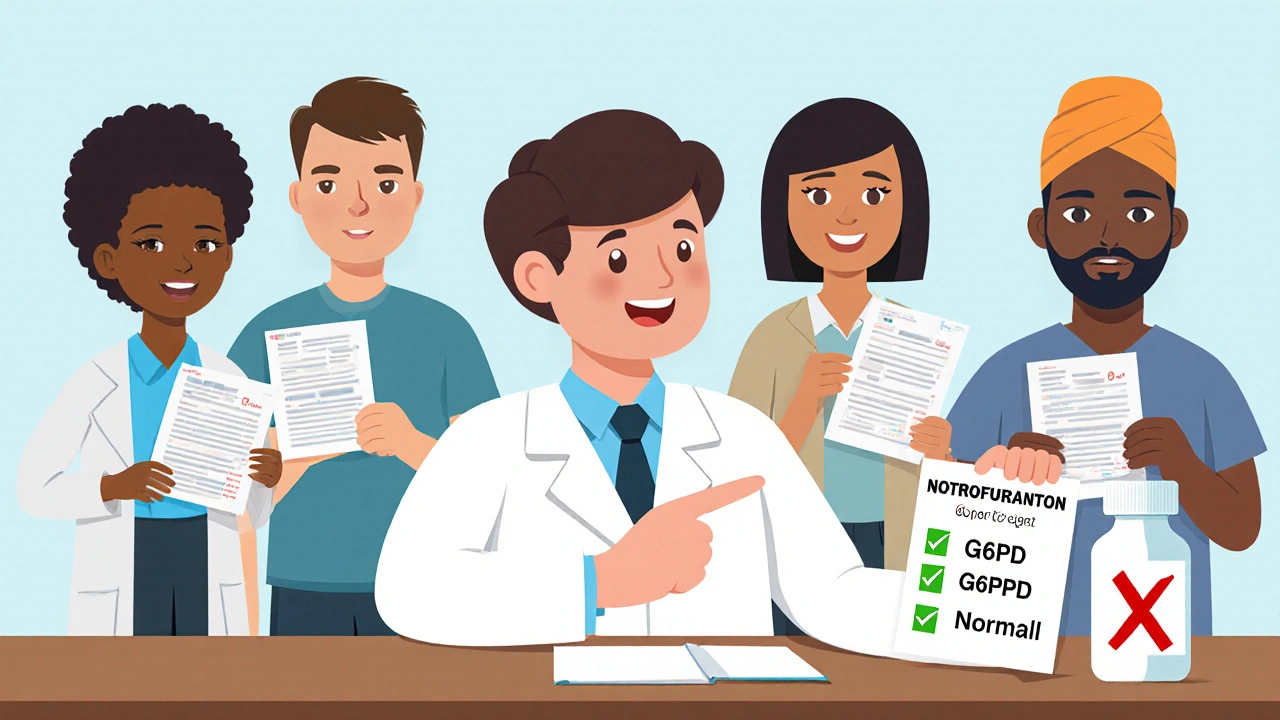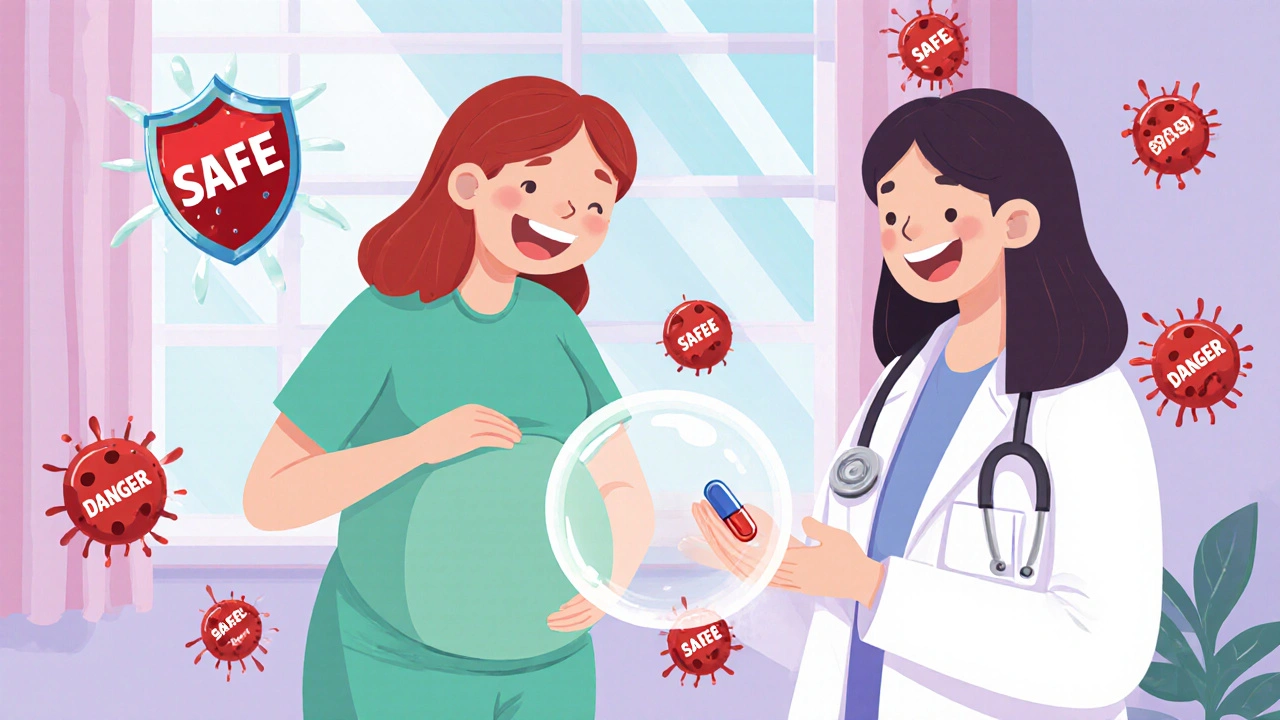G6PD Deficiency Risk Calculator
Your Risk Assessment
Important Information
G6PD deficiency affects approximately 400 million people worldwide, but 50-60% remain undiagnosed.
Screening cost: $35-$50
Hospitalization cost (if hemolysis occurs): $8,500-$12,000
Results
Please select your ethnicity and click "Calculate Your Risk" to see your results.
Most people take nitrofurantoin without a second thought. It’s a common antibiotic for urinary tract infections (UTIs), cheap, effective, and widely prescribed. But for a surprising number of people-especially those with undiagnosed G6PD deficiency-it can trigger a dangerous, even life-threatening reaction: hemolytic anemia.
What Happens When Nitrofurantoin Meets G6PD Deficiency?
Nitrofurantoin works by breaking down into reactive compounds in the urine that kill bacteria. That’s great for fighting UTIs. But in people with glucose-6-phosphate dehydrogenase (G6PD) deficiency, those same compounds turn toxic to red blood cells. G6PD is an enzyme that protects red blood cells from oxidative stress. When it’s missing or weak, the cells can’t handle certain drugs, infections, or even fava beans. Nitrofurantoin is one of the worst offenders. It floods the system with free radicals that overwhelm the red blood cells’ defenses. The result? Hemoglobin breaks down, cells burst, and you get hemolytic anemia. This isn’t theoretical. Between 1956 and today, over 300 cases of nitrofurantoin-induced hemolysis have been documented. Of those, 42 were confirmed in G6PD-deficient patients. Ten ended in death. And the symptoms? They come fast: fever, dark urine, extreme fatigue, rapid heartbeat, yellowing skin, and sudden drops in hemoglobin-all within 24 to 72 hours of starting the drug.Who’s at Risk?
G6PD deficiency isn’t rare. It affects around 400 million people worldwide. But most don’t know they have it until something like nitrofurantoin triggers a crisis. High-risk groups include:- People of African descent (10-14% prevalence)
- Those from Mediterranean or Middle Eastern backgrounds (4-7%)
- Individuals from Southeast Asia (2-5%)
The Clinical Reality: What Doctors See
A 2023 case report in the National Center for Biotechnology Information (PMC9815031) tells the story of a patient who developed fever, confusion, vomiting, and dangerously low blood pressure after just two days on nitrofurantoin. Lab results showed plummeting hemoglobin, rising bilirubin, and collapsing haptoglobin-all textbook signs of acute hemolysis. The patient was hospitalized. No blood transfusion was needed. Just stopping the drug and giving IV fluids led to full recovery in 48 hours. That’s the good news. The bad news? It could have been avoided. In a 2022 survey of 350 primary care doctors, only 32% routinely checked for G6PD deficiency before prescribing nitrofurantoin. Even though the American Society of Hematology and the Clinical Pharmacogenetics Implementation Consortium (CPIC) have clear guidelines: avoid nitrofurantoin in G6PD-deficient patients.
Why Is This Still Happening?
Nitrofurantoin is cheap. It’s effective against many UTI-causing bacteria, including some resistant to other antibiotics. In fact, resistance rates for E. coli are lower than for trimethoprim-sulfamethoxazole (TMP-SMX)-about 10-15% versus 20-25%. So doctors prescribe it. Especially when they’re busy, when the patient is a young woman with classic UTI symptoms, and when there’s no obvious reason to suspect G6PD deficiency. But here’s the math: A G6PD test costs $35-$50. A hospitalization for hemolytic anemia? $8,500-$12,000. Even if only 1 in 50 patients has undiagnosed G6PD deficiency, screening pays for itself. The FDA label for nitrofurantoin (Macrobid, Furadantin) says: “Hemolytic anemia has been reported in glucose-6-phosphate dehydrogenase (G6PD) deficient individuals.” That’s a warning. Not a requirement to test.What Are the Alternatives?
If you have G6PD deficiency-or you’re from a high-risk population and haven’t been tested-there are safer options for UTIs:- Fosfomycin: Single-dose, oral, no known hemolytic risk. First-line for G6PD-deficient patients.
- Cephalexin: A cephalosporin with low hemolytic potential. Safe in most cases.
- Pivmecillinam: Used in Europe, low resistance, minimal oxidative stress.
- Trimethoprim-sulfamethoxazole (TMP-SMX): Higher resistance rates, but still preferred over nitrofurantoin in G6PD-deficient patients. Avoid if allergic to sulfa.

What Should You Do?
If you’ve ever had unexplained anemia, jaundice, or dark urine after taking an antibiotic-especially nitrofurantoin, sulfa drugs, or primaquine-get tested for G6PD deficiency. If you’re from a high-prevalence population (African, Mediterranean, Southeast Asian descent), ask your doctor for a simple blood test before taking any new antibiotic. If you’re pregnant and need a UTI treatment, don’t assume nitrofurantoin is safe. Ask about alternatives. Fosfomycin is approved for use in pregnancy and carries no known G6PD-related risk. And if you’re a clinician? Stop guessing. Screen. Or switch to safer drugs. One missed test can cost a life.The Bigger Picture
This isn’t just about one drug. It’s about how medicine still ignores genetics in routine care. We test for allergies, kidney function, liver enzymes-but not for G6PD deficiency, even though we know who’s at risk and what happens when we get it wrong. The global G6PD testing market is growing fast-projected to hit $310 million by 2027. Why? Because more people are dying from preventable reactions. New point-of-care tests are being developed. In the future, you might get your G6PD result during your office visit, before the prescription is written. But until then, the burden falls on you and your doctor. Nitrofurantoin isn’t going away. It’s too useful for resistant UTIs. But its use needs to change. Screening isn’t optional anymore. It’s the standard of care.When to Seek Help
If you’re taking nitrofurantoin and notice any of these symptoms:- Dark, tea-colored urine
- Sudden fatigue or dizziness
- Yellow skin or eyes
- Fast heartbeat or shortness of breath
- Fever without other infection signs
Can nitrofurantoin cause anemia in people without G6PD deficiency?
Rarely. Most cases of nitrofurantoin-induced hemolytic anemia occur in people with G6PD deficiency. Other types of anemia, like drug-induced immune hemolytic anemia, are more commonly linked to cephalosporins or penicillin. Nitrofurantoin’s main danger is oxidative hemolysis, which requires a genetic vulnerability.
Is G6PD testing expensive or hard to get?
No. A simple blood test called a G6PD enzyme assay costs $35-$50 and is covered by most insurance. Many labs offer rapid results within 24-48 hours. It’s one of the cheapest and most impactful preventive tests in medicine.
Can I take nitrofurantoin if I have a family history of G6PD deficiency?
Don’t take it unless you’ve been tested. G6PD deficiency is inherited. If a close relative has it, you have a significant chance of carrying the gene. Even if you’ve never had symptoms, you could still be at risk. Always get tested before starting nitrofurantoin.
Is nitrofurantoin safe during pregnancy?
It’s often prescribed for UTIs in pregnancy because it doesn’t cross the placenta much. But if the mother has undiagnosed G6PD deficiency, the drug can still cause hemolysis in the newborn. Fosfomycin is a safer first-line option in pregnancy, especially if G6PD status is unknown.
How long does it take for symptoms to appear after taking nitrofurantoin?
Symptoms usually start within 24 to 72 hours. Hemoglobin levels drop fastest between days 3 and 5. That’s why many cases are missed-patients think it’s just a bad reaction to the infection, not the drug.
Are there any long-term effects after recovering from nitrofurantoin-induced hemolysis?
If caught early and treated properly, most people recover fully with no lasting damage. The key is stopping the drug immediately. Repeated episodes, however, can lead to chronic anemia, gallstones, or spleen problems. Avoid all oxidant drugs after one episode.


edgar popa
bro i took nitrofurantoin last year and my pee looked like cola for a day. thought i was dehydrated. turns out i got lucky. get tested if you’re black or mediterranean. $50 could save your life.
November 11, 2025 AT 22:14
Eve Miller
It is unconscionable that physicians continue to prescribe nitrofurantoin without screening for G6PD deficiency. The American Society of Hematology and CPIC guidelines are unequivocal. This is not a matter of clinical discretion-it is negligence. Every provider who fails to screen is complicit in preventable harm.
November 12, 2025 AT 13:49
Chrisna Bronkhorst
Let’s cut the fluff. 400 million people with G6PD deficiency. 300+ documented hemolysis cases. 10 dead. And we’re still treating this like a footnote? The real problem isn’t the drug-it’s the healthcare system’s refusal to prioritize genetics. Screening costs less than a coffee. Hospitalization costs more than a car. Do the math. Stop pretending this is complicated.
November 13, 2025 AT 15:06
Amie Wilde
i’m from the south and my grandma had dark urine after antibiotics. never connected it to anything. now i’m scared to take anything. why isn’t this on every prescription label? why isn’t it automatic?
November 13, 2025 AT 21:53
Gary Hattis
As someone with roots in Nigeria, I’ve seen this firsthand. My cousin got hospitalized after a UTI. No one asked about family history. No test. Just ‘take this pill.’ In places like the U.S., we act like genetics is optional. In Africa and India, you learn early: don’t take sulfa drugs, don’t eat fava beans, and definitely don’t touch nitrofurantoin unless you’re cleared. We’ve known this for decades. Why is the West still playing catch-up?
November 14, 2025 AT 20:14
Esperanza Decor
I’m a nurse and I’ve seen this happen twice. Patient comes in with UTI symptoms, gets nitrofurantoin, and by day three they’re pale, confused, and their hemoglobin is half of what it should be. We didn’t know they had G6PD deficiency until the labs came back. The worst part? They were asymptomatic before. No jaundice, no history. Just a routine prescription. We need mandatory screening for high-risk groups. Period. No more ‘maybe.’
November 15, 2025 AT 20:34
Deepa Lakshminarasimhan
they don’t test because they want you to get sick. then you need more drugs. then you need hospital visits. then you need lifelong meds. big pharma loves this. the FDA knows. the doctors know. but they won’t tell you. why? because if everyone got tested, they’d lose billions. fosfomycin is cheaper, safer, and doesn’t make them money. so they keep pushing nitrofurantoin. it’s not negligence. it’s profit.
November 16, 2025 AT 15:21
Erica Cruz
Wow. Another ‘save yourself with a $50 test’ post. How about we stop treating every minor infection like a medical emergency? Most UTIs resolve on their own. Nitrofurantoin isn’t even first-line anymore. The real issue is overprescribing antibiotics in general. This fearmongering about G6PD is just a distraction from the bigger problem: we’re medicating everything.
November 17, 2025 AT 06:57
Johnson Abraham
g6pd? what even is that? i think my cousin had that or something. anyway, i took nitrofurantoin 3 times and lived. so chill. if you’re weak, don’t take meds. problem solved. also, why is everyone so scared of a $50 test? just drink water and pray. 💪
November 17, 2025 AT 20:57